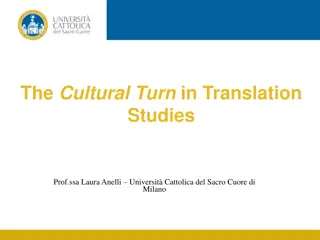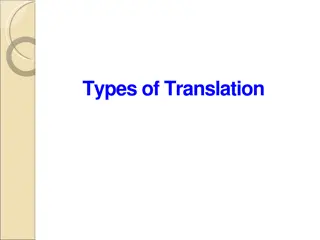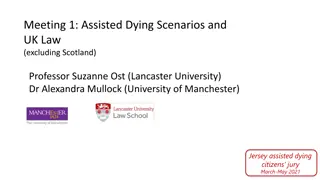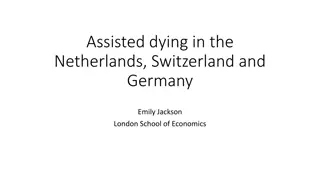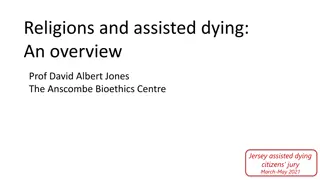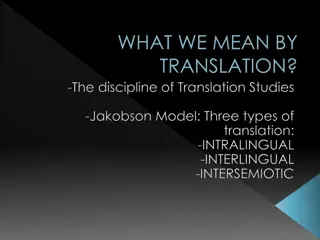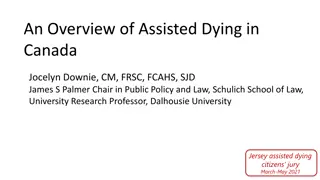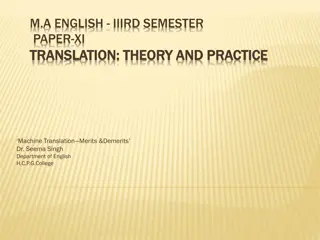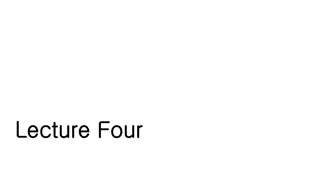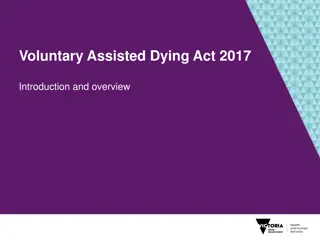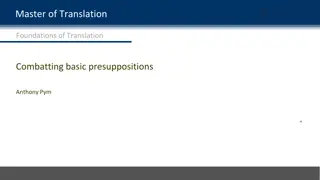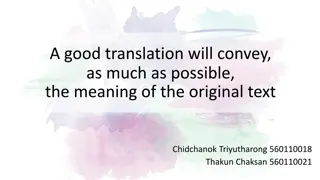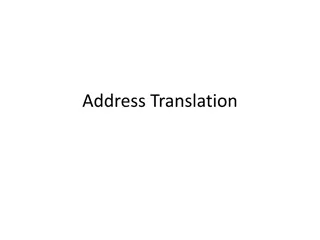The Future of Computer-Assisted Translation: Insights and Trends
Delve into the evolving landscape of computer-assisted translation (CAT) tools and technologies as discussed by Dieter Rummel, the Head of the IT Unit at the European Commission. Explore the impact of curiosity on CAT advancements, trends shaping translation environments, and the shifting dynamics in the Directorate General for Translation. Discover key factors driving changes in translated pages, staff numbers, and the utilization of electronic translation tools. Gain valuable insights on the challenges and opportunities presented by CAT tools and the evolving needs of the translation industry.
Download Presentation

Please find below an Image/Link to download the presentation.
The content on the website is provided AS IS for your information and personal use only. It may not be sold, licensed, or shared on other websites without obtaining consent from the author.If you encounter any issues during the download, it is possible that the publisher has removed the file from their server.
You are allowed to download the files provided on this website for personal or commercial use, subject to the condition that they are used lawfully. All files are the property of their respective owners.
The content on the website is provided AS IS for your information and personal use only. It may not be sold, licensed, or shared on other websites without obtaining consent from the author.
E N D
Presentation Transcript
Will curiosity kill the CAT? Thoughts on the future of the computer assisted translation environment Translating and the Computer 38, 16 November 2016 - London Dieter Rummel, Head of the IT Unit European Commission, DGT
Let's talk about CATs (literally) Curiosity Intermission: A short rant CATE 2020 an unspectacular vision DOGs
Directorate General for Translation 3
1 EU law, including the legislative process Main document types 2015 2%2%5% 2 Guardian of the Treaties/Implementation of EU law 3 Correspondence 2% 3% 4 Political documents 1% 5 Relations with other EU institutions 38% 11% 6 Communication, web, media, publications 6% 7 Budget, budgetary procedure 8 Documents linked to international organisations and non-EU countries 9 Notices for publication in OJ 14% 16% 10 Commission working or internal documents 11 Other 4
Evolution 2010-2015 Number of translated pages and number of DGT staff 2 500 000 2 580 2 560 2 000 000 Pages 2 540 2 520 1 500 000 2 500 1 000 000 Staff 2 480 2 460 500 000 2 440 0 2 420 5 2010 2011 2012 2013 2014 2015
Electronic translation tools Terminology IATE (public) EUR-Lex (public) Quest metasearch DGT Vista Electronic dictionaries, glossaries, Google, Wikipedia, etc. Translation tools SDL Studio Euramis MT@EC 6
Context "More (better) with less" More complexity, new formats, new ways of working Stronger recourse to outsourcing Ongoing or planned developments of corporate tools for document management and authoring Shift from documents to content
Not (always) a love story: translators and their tools "If it worked I would not need incentives" - User needs of subordinate interest to developers - " too many clicks!!!" Dissatisfaction caused by tool conception and design "I just want to translate!" - Significant number of users are irritated by the tools - Bugs and errors
In the meantime. 20th century: Computer tools facilitate or replace clerical tasks (Excel, Word etc.) 21st century: Support knowledge workers The rise of "Virtual personal assistants"? Shouldn't all our tools be User centric Context aware Always available but un-obtrusive Always useful Aware of their limitations
Intermission: a short rant! Translation memories: suffering from reversed dementia? Terminology: Not all that's correct is relevant MT: Getting better all the time but what is the added value? Formats: Will standards save the day? From lab to production?
CATE 2020 an unspectacular vision DGT CATE reflection launched in April 2014 Objectives: ensure continuity, but also prepare a sound and sustainable solution for the long term Involve translators in the reflection process Contribute to a vision for DGT's future CAT environment (2020) Interinstitutional reflection started in 2016
From CAT to CATE CATE: The Computer Assisted Translation Environment includes an ecosystem of language and workflow applications. Do not focus on standalone tools, but on creating a platform that permits the integration of many information sources and tools
CAT Environment Institution specific: DMS/CMS,TMS Euramis, IATE, MT@EC, DocFinder, Quest Further development of interinstitutional tools CAT Tool
What we do know The future CAT environment needs to be collaborative External Service Providers are an integral resource The EU's legislative process is by definition interinstitutional ATP: Translation as part of the Authoring- Translation-Publishing chain
CAT Environment Language Resources Translation memories (Central, project specific, shared) MT engines (Generic, domain specific) terminology databases (Central, project specific) Corpora (Central repository, job-specific reference material) Automatisation and integration Pre- and post-processing Format handling Batch processing CAT tool Language tools Communication Exchange of information on document or projects Sharing of language data Single point of access for translation, revision, editing, alignment QA (originals, translations)
What we don't know (yet?) From SMT to NMT to ? From dumb storage and reuse to learning systems? Will semantics help us search smarter? What will be the place of corpus linguistics? "Big Data" just a buzz word?
From CAT to CATE but how? No big-bang: Business continuity and sustainability are essential Flexibility: "One-tool-fits-all" Really? Maturity: avoid immature or half- finished products Continuity and sustainability are best served by a modular approach
a modular approach? Integrated and coherent working environment Be ready for whatever comes next Deal with the legacy Modernize, or die? Apply the "no legacy" principle? What will be "State of the art" in 2020? What will our "business" be like? How do you deal with uncertainty? More tools, less clicks? Translator or IT expert? What good are features and resources that no one uses?
a modular approach! Integrated and coherent working environment Be ready for whatever comes next Deal with the legacy Build on sound principles, e.g. International standards Interoperable solutions Service oriented architecture "Shareable" by design Keep it simple Focus on added value Modernize the legacy systems (but don't be sentimental) Remember: you do not build a cathedral, but a city.
Tools Principles + Technology Processes People
Dependable Open Graceful* *= agile, elegant
Thank you for your attention!




